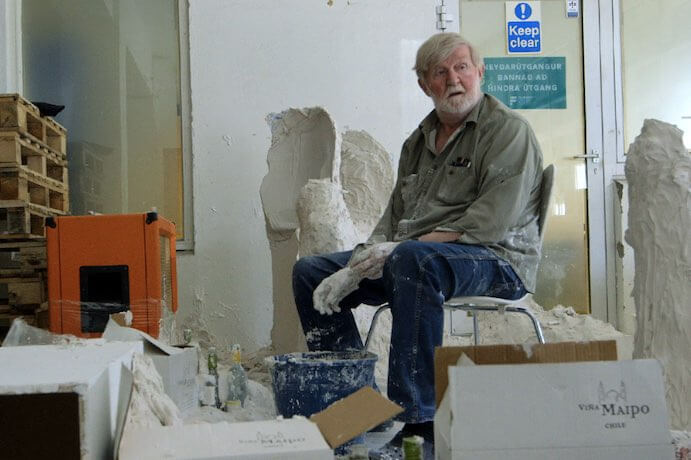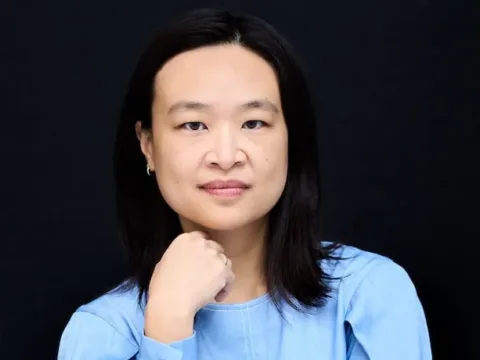Iceland is well known for its iconic experimental music scene. Most music enthusiasts likely know mainstream artists like Bjork or Sigur Ros, and new music audiences are have become familiar composers like Anna Thorvaldsdottir or indie labels like Bedroom Community. Adam Buffington’s work as a composer, performance artist, and researcher engages with Iceland’s long history as key node in transnational Fluxus networks. In 2021, he started a new record label Mumbling Eye with visual artist Tumi Magnússon, which is “dedicated to the publication of rare/unreleased sound art & ephemera.” We caught up with Adam to learn more about the record label, its debut release Gapassipi, and his creative and historical research.
Can you describe your background with Iceland’s experimental music and art scene and how these experiences inform your creative practice and academic research?
My connection to Iceland began in fall 2016, during a Master’s exchange with the music department at Iceland University of the Arts in Reykjavik. My exposure to Reykjavik’s vibrant scene coincided with a burgeoning fascination with Fluxus and absurdist/existential theater, two creative modes which (as I quickly discovered) were deeply embedded within the historical development of Reykjavik’s contemporary arts community. This connection immediately became the focus of my PhD research at The Ohio State University, beginning in fall 2017.
Initially, I concentrated on performativity and embodiment in contemporary Icelandic art, developing case studies of artists such as Ragnar Kjartansson, Margrét Bjarnadóttir, and Icelandic Love Corporation, amongst others. However, upon learning of prominent non-Icelandic artists’ activities in Reykjavik such as Nam June Paik, Charlotte Moorman, and John Cage, I switched focus to examine cross-cultural collaborations that transpired between Icelandic and non-Icelandic artists in Reykjavik during the later 20th century. Magnús Pálsson (b. 1929) was one Icelandic artist I concentrated on. With a diverse oeuvre constituted by sculpture, performance, sound art, theater, and video, his work has become my primary research focus, through both the establishment of Mumbling Eye, as well as a future book examining Pálsson’s role in experimental arts education during the late 1970s and 1980s.
My creative practice as a sound artist is ultimately entangled with my research, as both inform one another. I mainly work with cassette tapes and walkmans, mundane objects, and field recordings, oftentimes sonically assembled in a cut-up fashion. I’ve had several performances over the years in Reykjavik, and the heavily DIY approach to artmaking and distribution that I’ve encountered in my research there has undoubtedly informed my own attitude towards artmaking.

What motivated you to start the record label Mumbling Eye with Tumi Magnússon in 2021?
The initial idea for establishing a label like Mumbling Eye formed around 2017. For some time prior, I had been closely following similar initiatives in the Nordic region that were issuing out-of-print or unreleased sound works by Fluxus and experimental artists/composers during the later 20th century, including Institut for Dansk Lydarkæologi (Institute for Danish Sound Archaeology), Henning Christiansen Archive, and O. Gudmundsen Minde. Labels such as these provide a crucial platform for promoting greater awareness of experimental Nordic artists, enabling accessibility to their works, and filling in historical gaps within narratives surrounding later 20th century artistic developments like Fluxus.
I envisioned a similar label for Icelandic sound art. Since the exploration of sound’s performativity and spatiality have been a focus of Pálsson’s output since the 1980s, I approached Pálsson and his wife Frances Cowan with the idea of issuing his sound poetry, of which several works have never been officially released, or experienced beyond a live performance. Once Frances connected me with Pálsson’s son, artist Tumi Magnússon (whom I had previously met in Reykjavik in 2019), Tumi and I quickly began a lengthy discussion concerning the label’s operation, suitable works for release, and artists besides Pálsson that Mumbling Eye may feature. Thus, Mumbling Eye was born! (Mumbling Eye is named after a 1984 artist’s book Pálsson created with students, while lecturing at Jan van Eyck Academie in Maastricht, Netherlands.)

Mumbling Eye’s debut album Gapassipi is striking both for its high-quality recording of Magnús Pálsson’s playful sound/text installation and detailed liner notes featuring archival documents. Can you describe the process that went into producing the audio and the liner notes?
It was quite an extensive process, developing remotely via email over the course of 2021. The audio consists of the original tracks Pálsson had produced for the 1995 installation of Gapassipi at Reykjavik City Hall. The installation featured a 30-sq. meter triangular formation of broken glass upon the floor, and eight loudspeakers emanating Pálsson’s audio throughout the space. When you listen to the release, the right channel consists of Pálsson reciting vignettes of his memories surrounding the lake Tjörnin (where the City Hall is situated), while the left comprises of Pálsson loosely chanting a poem about the greylag goose. The greylag frequents Tjörnin yearly, and their V-shaped migration pattern was evoked by the triangular array of glass in the installation. Vivid photographs taken by Frances Cowan of the installation are reproduced in the release, along with a blueprint of Reykjavik City Hall Pálsson used to determine the layout of the speakers.
As Gapassipi is written and performed not in regular Icelandic, but rather the colloquial “P-Language” (a secret language spoken between Icelandic children to avoid adult understanding), Pálsson and Cowan contributed not only the original “P-ified” Icelandic text for the release, but also created a new “P-ified” English text as well. Thus, no direct Icelandic or English translations of the text are included! The translations involved much of Pálsson’s family, and I was thrilled about their involvement in this project.
The liner notes that I wrote not only detail the various components of the original 1995 installation and the significance behind P-Language, but also briefly contextualize the installation within Pálsson’s broader oeuvre, and discuss how the thematic survey of memory in Gapassipi is also indicative of a broader, vernacular memory of Reykjavik. Considering that Pálsson is all but unknown within the United States and other countries, it was imperative to give the reader/listener a sense of Pálsson’s significance to Icelandic art history, without overshadowing Gapassipi itself.
What other projects is Mumbling Eye currently producing? Are there any other pieces, albums, artists you hope to produce, and will you explore other production formats (video or material)?
Currently, we are beginning work on our next release, a CD of Pálsson’s installation/sound work Enginn Gleypir Sólina (No One Swallows the Sun). While Gapassipi was previously unreleased, Enginn Gleypir Sólina was originally released on cassette tape by the defunct Reykjavik space Galleri 11 in 1993. While we have not yet officially decided on the next release after Enginn Gleypir Sólina, we have discussed a number of Pálsson’s sound works from the 1990s and 2000s, including several written for and performed by Pálsson’s own Nýlokórinn (NÝLO Choir), which he established in 2003 and remains active today. We have also considered expanding into other media as well, with possibly releasing a compilation of Pálsson’s video works in the future. As for other Icelandic artists, we shall see! There are many options to explore.
What impact do you hope Mumbling Eye’s work will have, both for Iceland’s musical communities as well as scholars interested in the history of experimental music and art?
As we continue to plan and prepare future releases, I hope Mumbling Eye becomes a platform to promote greater awareness of Icelandic art and artists, for listeners in both Iceland and especially abroad. Furthermore, from a historical perspective, I envision Mumbling Eye as another avenue to further illuminate Icelandic artists’ obscured place within artistic narratives of the later 20th century. Iceland, as is much of the Nordic region, is often relegated to the periphery of contemporary art historiography, remaining marginalized in comparison with Western Europe and the United States. Investigating artists from nations like Iceland disrupts these narratives by challenging the peripherality of artists not from historically designated cultural “centers.” Such work ultimately injects further nuance and complexity into the broader understanding of contemporary art and music, who creates it, and where it is created.
I CARE IF YOU LISTEN is an editorially-independent program of the American Composers Forum, funded with generous donor and institutional support. Opinions expressed are solely those of the author and may not represent the views of ICIYL or ACF.
A gift to ACF helps support the work of ICIYL. For more on ACF, visit the “At ACF” section or composersforum.org.
























